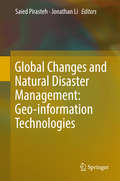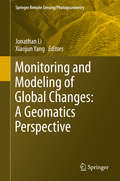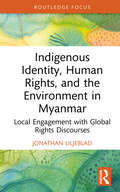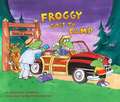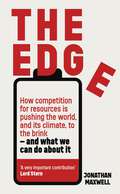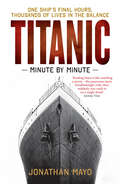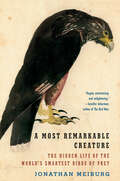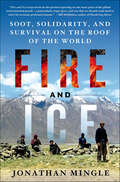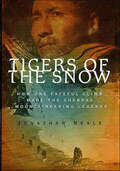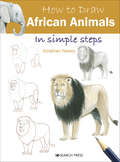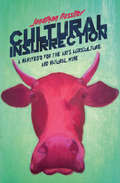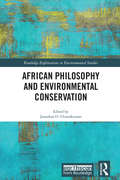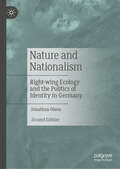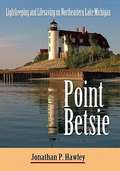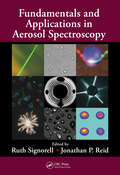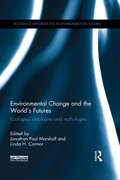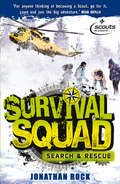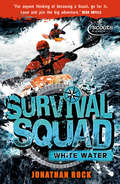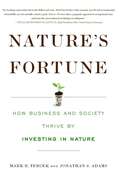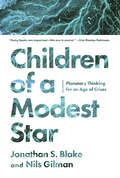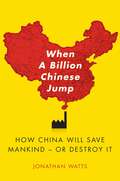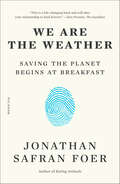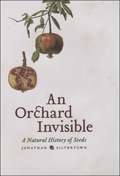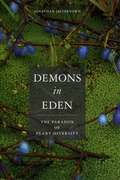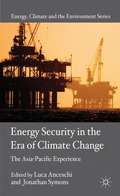- Table View
- List View
Global Changes and Natural Disaster Management: Geo-information Technologies
by Jonathan Li Saied PirastehThis book presents ongoing research and ideas related to earth observations and global change, natural hazards and disaster management studies, with respect to geospatial information technology, remote sensing, and global navigation satellite systems. Readers will discover uses of advanced geospatial tools, spatiotemporal models, and earth observation systems. Chapters identify the international aspects of the coupled social, land and climate systems in global change studies, and consider such global challenges as agriculture monitoring, the smart city, and risk assessment. The work presented here has been carefully selected, edited, and peer reviewed in order to advance research and development, as well as to encourage innovative applications of Geomatics technologies in global change studies. The book will appeal not only to academicians, but also to professionals, politicians and decision makers who wish to learn from the very latest and most innovative, quality research in this area of global change and natural disaster management. Contributions are drawn from revised submissions based on state-of-the-art papers from the 7th GiT4NDM - 5th EOGC, 2015 event.
Monitoring and Modeling of Global Changes: A Geomatics Perspective
by Xiaojun Yang Jonathan LiThe chapters in this book present state-of-the-art geomatics technologies applied in global environmental studies. This text provides the latest research findings and delivers complete references to related publications. This book will motivate the undergraduate and graduate students, researchers and practitioners to better understand the environmental changes with informed solutions. Global Change studies are increasingly considered a vital source of information to understand the Earth Environment, especially in the framework of human-induced, climate change and land use transformation. Satellite Earth Observing systems and geomatics technologies provide a unique tool to monitor and model the changes, respectively. While the range of applications and innovative techniques are always increasing, this book provides a summary of key study cases where satellite data offers critical information to understand the usefulness of the geomatics technologies and global environmental issues. Geomatics technologies provide powerful tools to model and analyze the effects of those global environmental changes towards minimizing their adverse impacts on human health and the environment.
Indigenous Identity, Human Rights, and the Environment in Myanmar: Local Engagement with Global Rights Discourses (Routledge Focus on Environment and Sustainability)
by Jonathan LiljebladThis book draws on the experiences of the indigenous movement in Myanmar to explore how the local construction of indigenous identities connects communities to global mechanisms for addressing human rights and environmental issues. Various communities in Myanmar have increasingly adapted international discourses of indigenous identity as a vehicle to access international legal mechanisms to address their human rights and environmental grievances against the Myanmar state. Such exercise of global discourses overlays historical endemic struggles of diverse peoples involving intersectional issues of self- determination, cultural survival, and control over natural resources. This book draws implications for the intersectionality of local and global theoretical discourses of indigeneity, human rights, and environment. It uses such implications to identify attendant issues for the aspirations of international human rights and environmental efforts and the practice of their associated international legal mechanisms. This book informs readers of the agency and capabilities of communities in underdeveloped countries to engage different global mechanisms to address local grievances against their states. Readers will develop a more critical understanding of the issues posed by the local construction of indigeneity for the ideals and practice of international efforts regarding human rights and the environment. This book will be of great interest to students and scholars of indigenous studies, human rights, international law, Asian studies, development studies, and the environment.
Froggy Goes to Camp
by Jonathan LondonLook out, Camp Run-A-Muck! Here comes Froggy... Froggy's off to camp--and Camp Run-A-Muck will never be the same! Froggy packs a lot into one week: hikes and archery lessons, K.P. and food fights, scary stories and funny songs around the campfire. But only Froggy could also manage to lose his trunks during swim class and overturn his kayak with the camp director in it. Lovable, bumbling Froggy will keep his many fans laughing with his latest antics.
The Edge: How competition for resources is pushing the world, and its climate, to the brink – and what we can do about it.
by Jonathan MaxwellWe live in a World which, though the origins are long, seems suddenly transformed by economic events way out of our control. In seeking stability, we must acknowledge the seismic scale of the challenge, and understand the devastating impact of global energy inefficiency. Every society, organisation, business, household and individual must put efficiency first - not just to save money and carbon and improve resilience, but to reduce the risk, or effect, of conflict.THE EDGE is a very contemporary look at how the world has been transformed by recent economic events, focusing on climate change, the war in Ukraine, the Chinese economy and the challenges the world faces around inflation, energy, transport, fuel, imports etc. Written from an economist/investor's perspective, with lessons for pretty much every institution challenged by these developments, it is a timely and essential resource authored by a global expert with peerless connections, from major organisations to government insiders, from investors to energy corporations. It will help businesses and economies currently at the mercy of the markets to transition towards sustainability, productivity and prosperity, and help everyone understand the world in 2023.
Titanic: Minute By Minute (Minute By Minute Ser.)
by Jonathan Mayo2.20am on 15th April 1912, the Titanic is plunging 12,000 feet to the ocean floor.Machinery, coal, crystal goblets, pianos and jewellery all tumbled through the dark water. Hundreds of passengers and crew remained trapped below decks – hundreds more would perish on the surface.This is the definitive chronology of the Titanic’s final hours, offering readers a real-time experience of one of the greatest dramas of twentieth century history.
A Most Remarkable Creature: The Hidden Life and Epic Journey of the World's Smartest Birds of Prey
by Jonathan Meiburg&“A fascinating, entertaining, and totally engrossing story.&”—David Sibley, author of What It's Like to Be a Bird &“Utterly captivating and beautifully written, this book is a hugely entertaining and enlightening exploration of a bird so wickedly smart, curious, and social, it boggles the mind.&”—Jennifer Ackerman, author of The Bird Way &“As curious, wide-ranging, gregarious, and intelligent as its subject.&”—Charles C. Mann, author of 1491 An enthralling account of a modern voyage of discovery as we meet the clever, social birds of prey called caracaras, which puzzled Darwin, fascinate modern-day falconers, and carry secrets of our planet's deep past in their family history.In 1833, Charles Darwin was astonished by an animal he met in the Falkland Islands: handsome, social, and oddly crow-like falcons that were "tame and inquisitive . . . quarrelsome and passionate," and so insatiably curious that they stole hats, compasses, and other valuables from the crew of the Beagle. Darwin wondered why these birds were confined to remote islands at the tip of South America, sensing a larger story, but he set this mystery aside and never returned to it. Almost two hundred years later, Jonathan Meiburg takes up this chase. He takes us through South America, from the fog-bound coasts of Tierra del Fuego to the tropical forests of Guyana, in search of these birds: striated caracaras, which still exist, though they're very rare. He reveals the wild, fascinating story of their history, origins, and possible futures. And along the way, he draws us into the life and work of William Henry Hudson, the Victorian writer and naturalist who championed caracaras as an unsung wonder of the natural world, and to falconry parks in the English countryside, where captive caracaras perform incredible feats of memory and problem-solving. A Most Remarkable Creature is a hybrid of science writing, travelogue, and biography, as generous and accessible as it is sophisticated, and absolutely riveting.
Fire and Ice: Soot, Solidarity, and Survival on the Roof of the World
by Jonathan MingleHigh in the Himalayan valley of Zanskar in northwest India sits a village as isolated as the legendary Shangri-La. Long fed by runoff from glaciers and lofty snowfields, Kumik—a settlement of thirty nine mud brick homes—has survived and thrived in one of the world's most challenging settings for a thousand years. But now its people confront an existential threat: chronic, crippling drought, which leaves the village canal dry and threatens to end their ancient culture of farming and animal husbandry. Fire and Ice weaves together the story of Kumik's inspiring response to this calamity with the story of black carbon. Black carbon from inefficient fires - the particulate residue that makes soot dark - is the second largest contributor to global warming after carbon dioxide. It's also a key ingredient of the air pollution that public health experts regard as humanity's greatest environmental health risk worldwide: soot-laden smoke from household hearth fires and outdoor sources combine to kill over seven million people around the world every year. Jonathan Mingle describes the joys and struggles of daily life in the Zanskar Valley, where villagers are buffeted by powerful environmental and economic forces, while also tracing black carbon's dark fingerprints outward from Kumik and around the world. Mingle investigates its impacts on snow, ice, and water from Mt. Everest to California, and the silent health epidemic it fuels from New York to New Delhi. Combining cultural history, detailed reportage, climate and energy science and dramatic storytelling, Fire and Ice is a profound examination of the global challenges of averting climate chaos and lifting billions out of energy poverty and water scarcity. Can Kumik's people come together to reinvent fire, harness what remains of their life-sustaining ice, and reinvigorate their traditions of solidarity, in time to save themselves? Can the rest of us rise to the same challenge? Fire and Ice connects these questions with the work of enterprising scientists, engineers, entrepreneurs and activists around the world, in a narrative that combines mythology, reason, humor, persistence, and hope in a race against a global clock.
Tigers of the Snow: How One Fateful Climb Made the Sherpas Mountaineering Legends
by Jonathan NealeTigers of the Snow is true story of the tragedy and survival on one of the world's most dangerous mountains.In 1922 Himalayan climbers were British gentlemen, and their Sherpa and Tibetan porters were "coolies," unskilled and inexperienced casual laborers. By 1953 Sherpa Tenzing Norgay stood on the summit of Everest, and the coolies had become the "Tigers of the Snow."Jonathan Neale's absorbing book is both a compelling history of the oft-forgotten heroes of mountaineering and a gripping account of the expedition that transformed the Sherpas into climbing legends. In 1934 a German-led team set off to climb the Himalayan peak of Nanga Parbat, the ninth highest mountain on earth. After a disastrous assault in 1895, no attempt had been made to conquer the mountain for thirty-nine years. The new Nazi government was determined to prove German physical superiority to the rest of the world. A heavily funded expedition was under pressure to deliver results. Like all climbers of the time, they did not really understand what altitude did to the human body. When a hurricane hit the leading party just short of the summit, the strongest German climbers headed down and left the weaker Germans and the Sherpas to die on the ridge. What happened in the next few days of death and fear changed forever how the Sherpa climbers thought of themselves. From that point on, they knew they were the decent and responsible people of the mountain.Jonathan Neale interviewed many old Sherpa men and women, including Ang Tsering, the last man off Nanga Parbat alive in 1934. Impeccably researched and superbly written, Tigers of the Snow is the compelling narrative of a climb gone wrong, set against the mountaineering history of the early twentieth century, the haunting background of German politics in the 1930s, and the hardship and passion of life in the Sherpa valleys.
How to Draw: African Animals
by Jonathan NeweyCapture the splendour of the African savannah by drawing this collection of stunning animals and birds. Watch them come to life in six easy steps. Award-winning artist Jonathan Newey teaches you to transform simple shapes into the iconic Big Five (lion, leopard, rhinoceros, elephant and buffalo), as well as towering giraffes, distinctive zebras and striking flamingos. There are 26 different animals to create, in a variety of poses and styles. Each project starts with a few basic outlines and progresses into a finished tonal drawing, and a final coloured version shows you how to develop your drawing even further. Perfect for beginners, as well as budding artists, you’ll be amazed how easily you too can draw African animals with this inspiring guide.
Cultural Insurrection: A Manifesto for Arts, Agriculture, and Natural Wine
by Jonathan NossiterFrom the director of Mondovino, a lively discussion of the expanding world of natural wine that considers the movement as a potential remedy for our current cultural crisis. What if, ten years from now, an artist--a filmmaker, for example--will have become as marginal and anachronistic as a blacksmith? What if the actors in the cultural world are on the brink of extinction, not about to disappear like prehistoric animals, but worse--submitting to the status quo? Absorbed by a marketplace that increasingly devalues true artistic work?In Cultural Insurrection, award-winning filmmaker and sommelier Jonathan Nossiter considers these questions and offers a solution inspired by the rebellious, innovative figures transforming the way we produce and consume wine. This new generation of artisans, working closely with the earth to create exceptional natural wines, has assumed the role of dissenters that artists have abandoned, and we should look to them in order to revitalize contemporary art.
African Philosophy and Environmental Conservation (Routledge Explorations in Environmental Studies)
by Jonathan O. ChimakonamAfrican Philosophy and Environmental Conservation is about the unconcern for, and marginalisation of, the environment in African philosophy. The issue of the environment is still very much neglected by governments, corporate bodies, academics and specifically, philosophers in the sub-Saharan Africa. The entrenched traditional world-views which give a place of privilege to one thing over the other, as for example men over women, is the same attitude that privileges humans over the environment. This culturally embedded orientation makes it difficult for stake holders in Africa to identify and confront the modern day challenges posed by the neglect of the environment. In a continent where deep-rooted cultural and religious practices, as well as widespread ignorance, determine human conduct towards the environment, it becomes difficult to curtail much less overcome the threats to our environment. It shows that to a large extent, the African cultural privileging of men over women and of humans over the environment somewhat exacerbates and makes the environmental crisis on the continent intractable. For example, it raises the challenging puzzle as to why women in Africa are the ones to plant the trees and men are the ones to fell them. Contributors address these salient issues from both theoretical and practical perspectives, demonstrating what African philosophy could do to ameliorate the marginalisation which the theme of environment suffers on the continent. Philosophy is supposed to teach us how to lead the good life in all its forms; why is it failing in this duty in Africa specifically where the issue of environment is concerned? This book which trail-blazes the field of African Philosophy and Environmental Ethics will be of great interest to students and scholars of Philosophy, African philosophy, Environmental Ethics and Gender Studies.
Nature and Nationalism: Right-wing Ecology and the Politics of Identity in Germany
by Jonathan OlsenIn this new edition of his now classic 1999 book, Jonathan Olsen explores the relationship between the far right and the environment, or what he terms “right-wing ecology.” Arguing that radical environmentalism is not exclusively a domain of the left, Olsen shows how many of Germany's far right parties and groups ground their ecological ideology in an anti-universalist anthropology which sees human beings as naturally 'rooted' in specific nations and cultural traditions. Pollution in this discourse signifies not only the disruption of the natural world, but the social world as well, thus providing an environmental justification for an anti-immigrant politics which finds resonance outside the specific milieu of the far right. A rigorously theoretical book, Nature and Nationalism challenges our understanding of the deeply ambiguous ways in which 'nature' functions to legitimate a wide variety of political ideas.
Point Betsie: Lightkeeping and Lifesaving on Northeastern Lake Michigan
by Jonathan P. HawleyPoint Betsie: Lightkeeping and Lifesaving on Northeastern Lake Michigan is the compelling story of a key Great Lakes lighthouse whose beam has pierced night skies for 150 years. This rich history recounts the efforts of the U. S. Lighthouse Service, the U. S. Life-Saving Service, and the U. S. Coast Guard on Lake Michigan's wreck-strewn northeastern coast, near the treacherous Manitou Passage. Much of Point Betsie's story is told in the accounts of dedicated keepers who served there with their families since 1858. Photographs also chronicle the lighthouse's expanding services through the years and the site's transition from early isolation to today's frequently visited attraction on Lake Michigan's northeastern shore. The author devotes equal attention to the courageous lifesaving crews that served mariners off Point Betsie from 1877 to 1937. Keepers' logs bring to life the heroic rescues from wrecks that surfmen discovered while conducting their lonely night-time beach patrols, and document Point Betsie's central but previously untold role in the area's important maritime and social history. Point Betsie also covers the "laker" fleet's evolution from wooden sailing vessels to massive steamships. Lighthouse operations are detailed, starting with Point Betsie's original oil lamps and then state-of-the-art Fresnel lens, and culminating with the electrically powered, automated beacon that now shines atop this historic and revered tower.
Fundamentals and Applications in Aerosol Spectroscopy
by Ruth Signorell Jonathan P. ReidHelping you better understand the processes, instruments, and methods of aerosol spectroscopy, Fundamentals and Applications in Aerosol Spectroscopy provides an overview of the state of the art in this rapidly developing field. It covers fundamental aspects of aerosol spectroscopy, applications to atmospherically and astronomically relevant problem
Environmental Change and the World's Futures: Ecologies, ontologies and mythologies (Routledge Explorations in Environmental Studies)
by Jonathan Paul Marshall and Linda H. ConnorClimate change and ecological instability have the potential to disrupt human societies and their futures. Cultural, social and ethical life in all societies is directed towards a future that can never be observed, and never be directly acted upon, and yet is always interacting with us. Thinking and acting towards the future involves efforts of imagination that are linked to our sense of being in the world and the ecological pressures we experience. The three key ideas of this book – ecologies, ontologies and mythologies – help us understand the ways people in many different societies attempt to predict and shape their futures. Each chapter places a different emphasis on the linked domains of environmental change, embodied experience, myth and fantasy, politics, technology and intellectual reflection, in relation to imagined futures. The diverse geographic scope of the chapters includes rural Nepal, the islands of the Pacific Ocean, Sweden, coastal Scotland, North America, and remote, rural and urban Australia. This book will appeal to researchers and students in anthropology, sociology, environmental studies, cultural studies, psychology and politics.
Survival Squad: Book 2 (Survival Squad #2)
by Jonathan RockThere's a reason they're known as the Survival Squad...It's winter and the snow is falling thick and fast. The Tiger Patrol are learning to ski, building snow shelters, and igloos. They're even working with the local search and rescue team. Then they're caught in a snow blizzard and a young girl is missing in the snow...Time is running out for the Survival Squad.
Survival Squad: Book 4
by Jonathan RockThere's a reason they're known as the Survival Squad...A white water rafting expedition for the Tiger Patrol takes a turn for the worse when the water level rises. It's a matter of life or death, and they have only their training and skill to rely on.
Nature's Fortune: How Business and Society Thrive by Investing in Nature
by Jonathan S. Adams Mark R. TercekWhat is nature worth? The answer to this question-which traditionally has been framed in environmental terms-is revolutionizing the way we do business. In Nature’s Fortune, Mark Tercek, CEO of The Nature Conservancy and former investment banker, and science writer Jonathan Adams argue that nature is not only the foundation of human well-being, but also the smartest commercial investment any business or government can make. The forests, floodplains, and oyster reefs often seen simply as raw materials or as obstacles to be cleared in the name of progress are, instead, as important to our future prosperity as technology or law or business innovation. Who invests in nature, and why? What rates of return can it produce? When is protecting nature a good investment? With stories from the South Pacific to the California coast, from the Andes to the Gulf of Mexico and even to New York City, Nature’s Fortune shows how viewing nature as green infrastructure allows for breakthroughs not only in conservation-protecting water supplies; enhancing the health of fisheries; making cities more sustainable, livable and safe; and dealing with unavoidable climate change-but in economic progress, as well. Organizations obviously depend on the environment for key resources-water, trees, and land. But they can also reap substantial commercial benefits in the form of risk mitigation, cost reduction, new investment opportunities, and the protection of assets. Once leaders learn how to account for nature in financial terms, they can incorporate that value into the organization’s decisions and activities, just as habitually as they consider cost, revenue, and ROI. Such a rethinking of "natural capital”-nature as a quantifiable asset-can not only increase profitability, but provide crucial protection against the kinds of climate change-driven phenomena-like devastating drought and hundred-year floods-that are no longer the stuff of speculation. A must-read for business leaders, CEOs, investors, and environmentalists alike, Nature’s Fortune offers an essential guide to the world’s economic-and environmental-well-being.
Children of a Modest Star: Planetary Thinking for an Age of Crises
by Nils Gilman Jonathan S. BlakeA clear-eyed and urgent vision for a new system of political governance to manage planetary issues and their local consequences. Deadly viruses, climate-changing carbon molecules, and harmful pollutants cross the globe unimpeded by national borders. While the consequences of these flows range across scales, from the planetary to the local, the authority and resources to manage them are concentrated mainly at one level: the nation-state. This profound mismatch between the scale of planetary challenges and the institutions tasked with governing them is leading to cascading systemic failures. In the groundbreaking Children of a Modest Star, Jonathan S. Blake and Nils Gilman not only challenge dominant ways of thinking about humanity's relationship to the planet and the political forms that presently govern it, but also present a new, innovative framework that corresponds to our inherently planetary condition. Drawing on intellectual history, political philosophy, and the holistic findings of Earth system science, Blake and Gilman argue that it is essential to reimagine our governing institutions in light of the fact that we can only thrive if the multi-species ecosystems we inhabit are also flourishing. Aware of the interlocking challenges we face, it is no longer adequate merely to critique our existing systems or the modernist assumptions that helped create them. Blake and Gilman propose a bold, original architecture for global governance—what they call planetary subsidiarity—designed to enable the enduring habitability of the Earth for humans and non-humans alike. Children of a Modest Star offers a clear-eyed and urgent vision for constructing a system capable of stabilizing a planet in crisis.
When A Billion Chinese Jump: How China Will Save Mankind -- Or Destroy It
by Jonathan S. WattsAs a young child, Jonathan Watts believed if everyone in China jumped at the same time, the earth would be shaken off its axis, annihilating mankind. Now, more than thirty years later, as a correspondent for The Guardian in Beijing, he has discovered it is not only foolish little boys who dread a planet-shaking leap by the world’s most populous nation. When a Billion Chinese Jump is a road journey into the future of our species. Traveling from the mountains of Tibet to the deserts of Inner Mongolia via the Silk Road, tiger farms, cancer villages, weather-modifying bases, and eco-cities, Watts chronicles the environmental impact of economic growth with a series of gripping stories from the country on the front line of global development. He talks to nomads and philosophers, entrepreneurs and scientists, rural farmers and urban consumers, examining how individuals are trying to adapt to one of the most spectacular bursts of change in human history, then poses a question that will affect all of our lives: Can China find a new way forward or is this giant nation doomed to magnify the mistakes that have already taken humanity to the brink of disaster?
We Are the Weather: Saving the Planet Begins at Breakfast
by Jonathan Safran FoerIn We Are the Weather, Jonathan Safran Foer explores the central global dilemma of our time in a surprising, deeply personal, and urgent new way. Some people reject the fact, overwhelmingly supported by scientists, that our planet is warming because of human activity. But do those of us who accept the reality of human-caused climate change truly believe it? If we did, surely we would be roused to act on what we know. Will future generations distinguish between those who didn’t believe in the science of global warming and those who said they accepted the science but failed to change their lives in response?The task of saving the planet will involve a great reckoning with ourselves—with our all-too-human reluctance to sacrifice immediate comfort for the sake of the future. We have, he reveals, turned our planet into a farm for growing animal products, and the consequences are catastrophic. Only collective action will save our home and way of life. And it all starts with what we eat—and don’t eat—for breakfast.
An Orchard Invisible: A Natural History of Seeds
by Jonathan SilvertownThe story of seeds, in a nutshell, is a tale of evolution. From the tiny sesame that we sprinkle on our bagels to the forty-five-pound double coconut borne by the coco de mer tree, seeds are a perpetual reminder of the complexity and diversity of life on earth. With An Orchard Invisible, Jonathan Silvertown presents the oft-ignored seed with the natural history it deserves, one nearly as varied and surprising as the earth's flora itself.Beginning with the evolution of the first seed plant from fernlike ancestors more than 360 million years ago, Silvertown carries his tale through epochs and around the globe. In a clear and engaging style, he delves into the science of seeds: How and why do some lie dormant for years on end? How did seeds evolve? The wide variety of uses that humans have developed for seeds of all sorts also receives a fascinating look, studded with examples, including foods, oils, perfumes, and pharmaceuticals. An able guide with an eye for the unusual, Silvertown is happy to take readers on unexpected--but always interesting--tangents, from Lyme disease to human color vision to the Salem witch trials. But he never lets us forget that the driving force behind the story of seeds-- its theme, even-- is evolution, with its irrepressible habit of stumbling upon new solutions to the challenges of life. "I have great faith in a seed," Thoreau wrote. "Convince me that you have a seed there, and I am prepared to expect wonders." Written with a scientist's knowledge and a gardener's delight, An Orchard Invisible offers those wonders in a package that will be irresistible to science buffs and green thumbs alike.
Demons in Eden: The Paradox of Plant Diversity
by Jonathan SilvertownJonathan Silvertown here explores the astonishing diversity of plant life in regions as spectacular as the verdant climes of Japan, the lush grounds of the Royal Botanical Gardens at Kew, the shallow wetlands and teeming freshwaters of Florida, the tropical rainforests of southeast Mexico, and the Canary Islands archipelago, whose evolutionary novelties--and exotic plant life--have earned it the sobriquet the Galápagos of botany. Along the way, Silvertown looks closely at the evolution of plant diversity in these locales and explains why such variety persists in light of ecological patterns and evolutionary processes. In novel and useful ways, he also investigates the current state of plant diversity on the planet to show the ever-challenging threats posed by invasive species and humans. This paperback edition will include an entirely new chapter on the astonishing diversity of plant life in the Western Cape of South Africa that focuses on fynbos, a vegetation endemic to the Cape. Bringing the secret life of plants into more colorful and vivid focus than ever before, Demons in Eden is an empathic and impassioned exploration of modern plant ecology that unlocks evolutionary mysteries of the natural world.
Energy Security in the Era of Climate Change
by Jonathan Symons Luca AnceschiLeading scholars assess the transformations in energy security policy that flow from recognition of global climate change. They explore through case studies the key policy responses formulated in the Asia-Pacific and identify potential synergies between energy policy and climate mitigation efforts.
